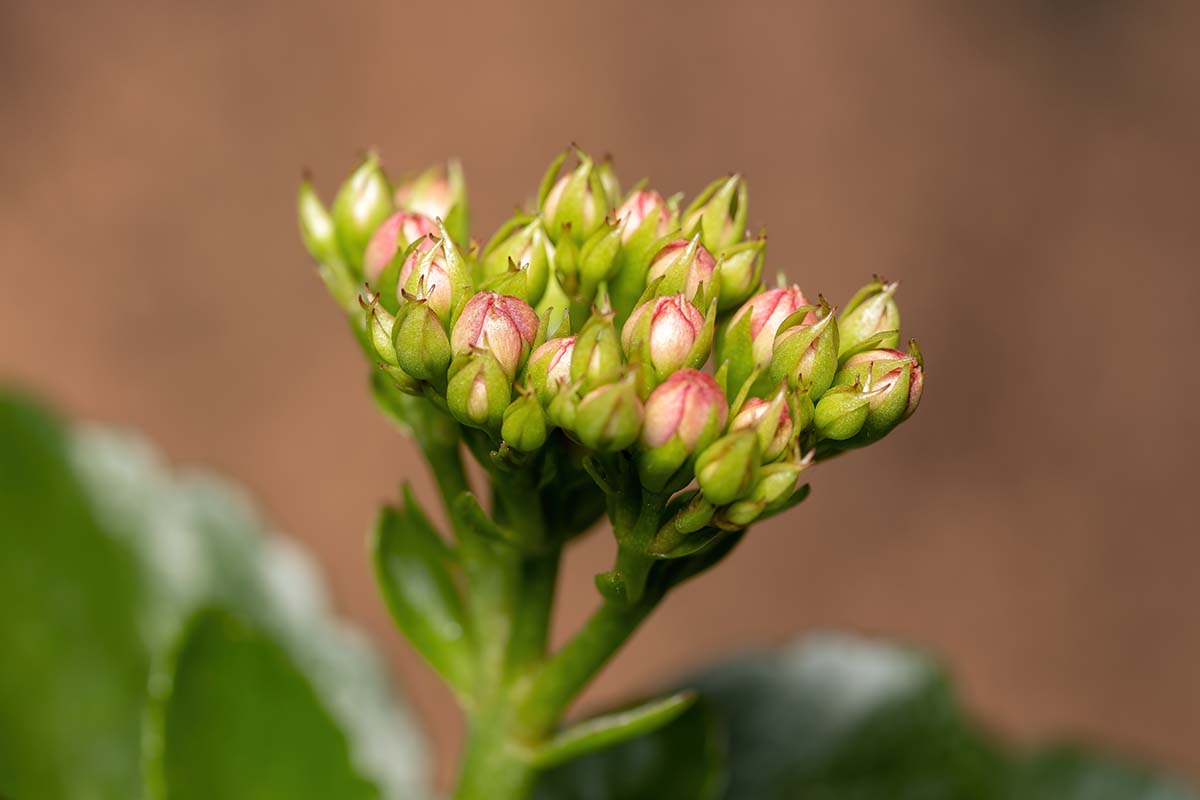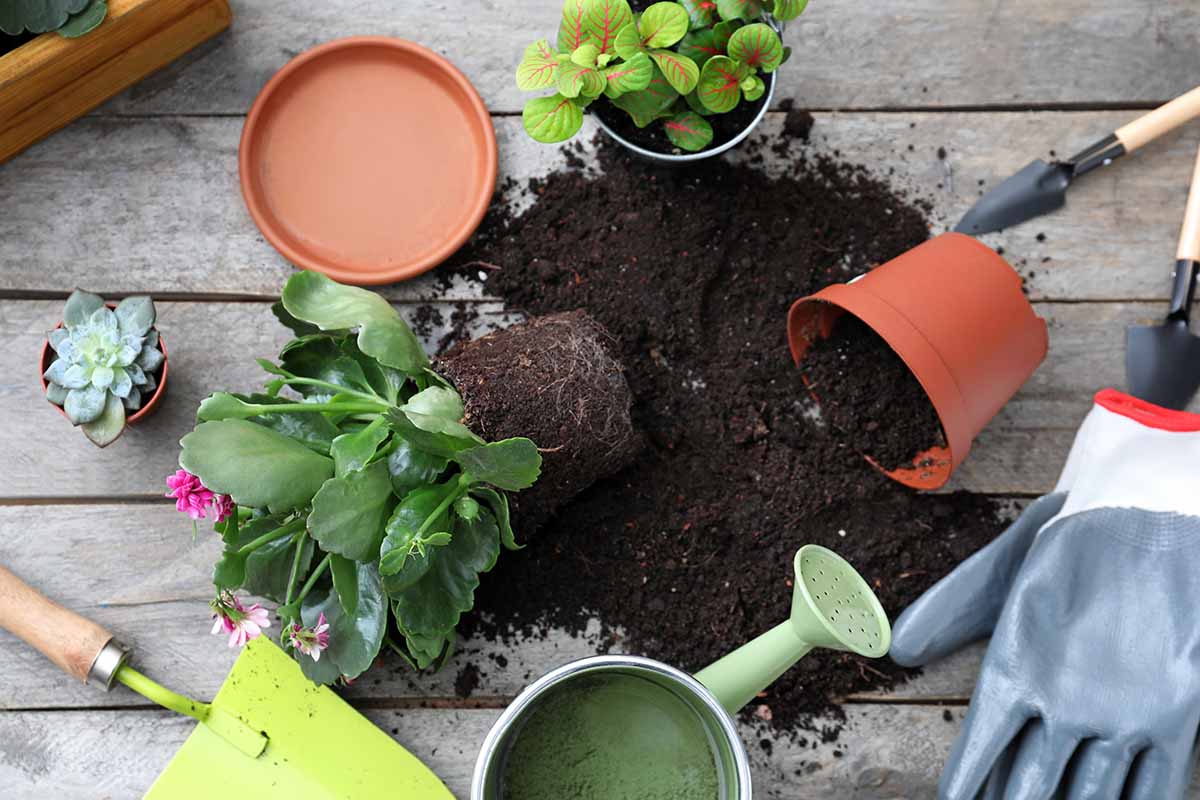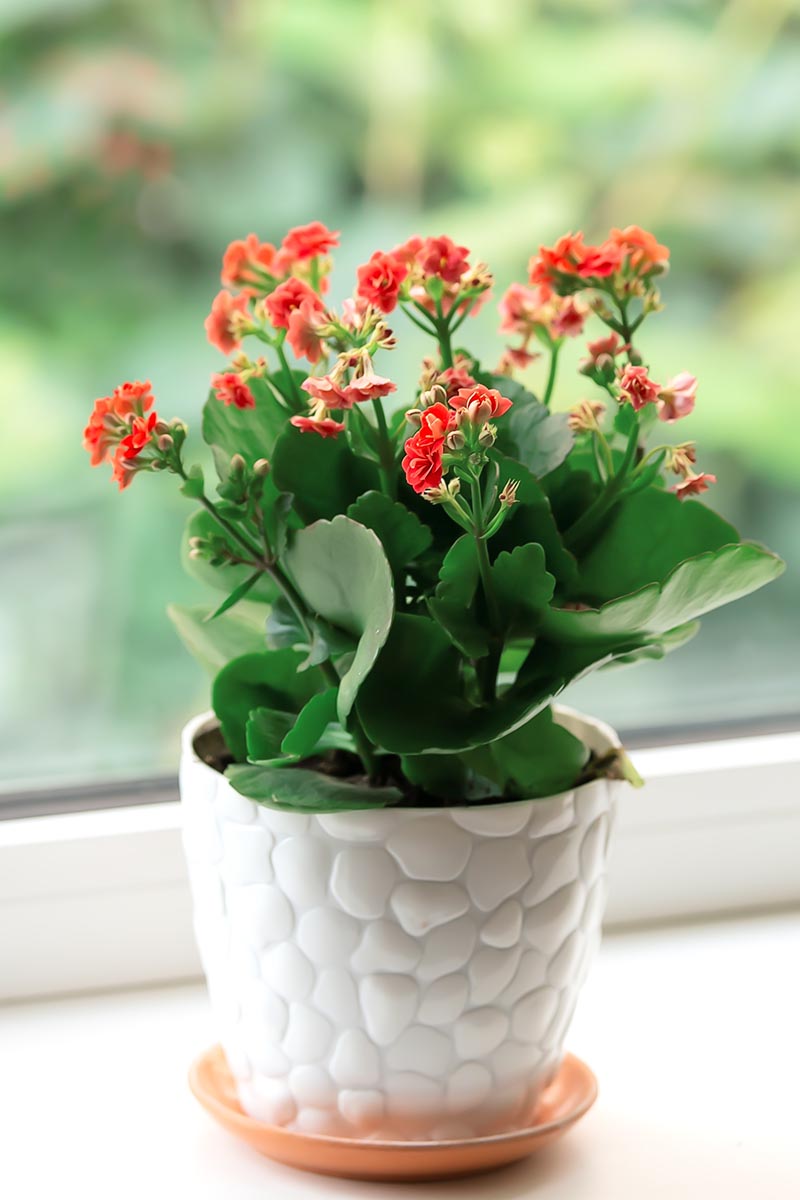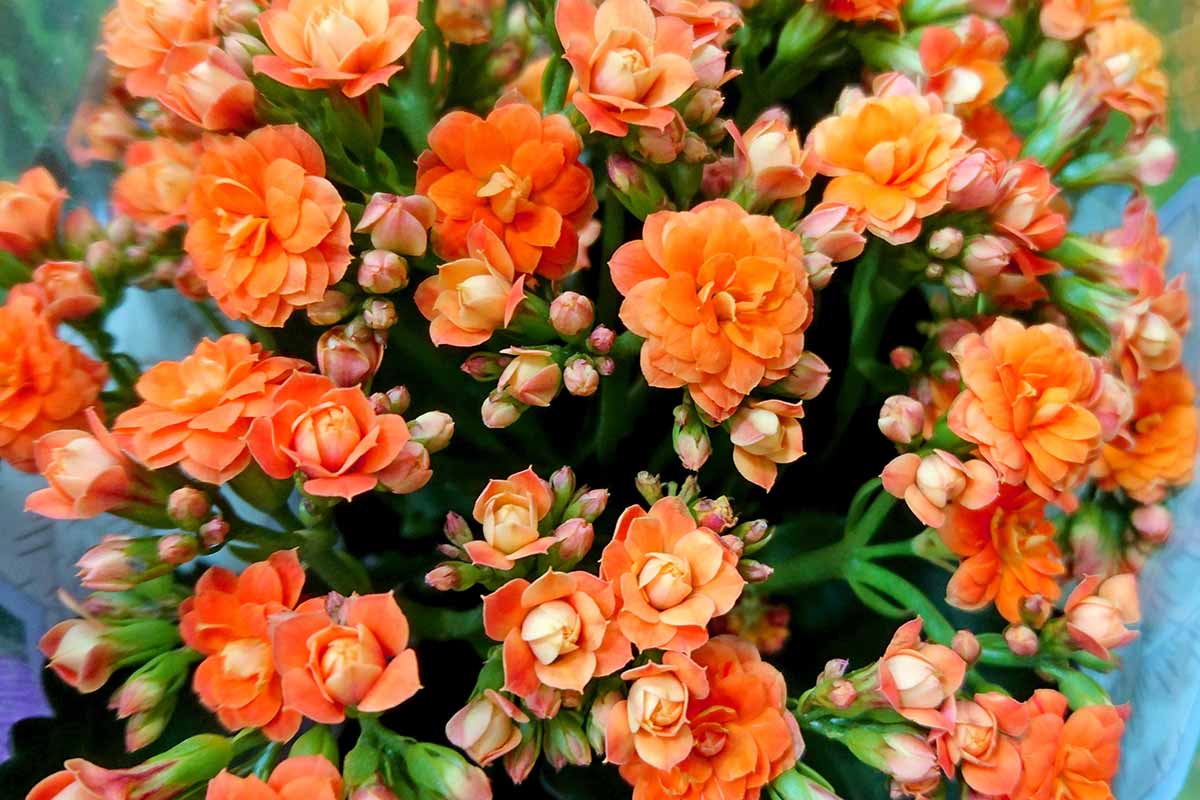It’s so cute that indoor gardeners use the word “force” to talk about how hard they work to get florist’s kalanchoe (Kalanchoe blossfeldiana) and other plants to bloom again.
You must admit it’s impossible to truly force a member of the plant kingdom to do anything. When someone says “force,” I picture a bad guy standing over a plant and saying, “We have ways to make you flower…”
But while you can’t technically “force” K. blossfeldiana to form new buds or bloom, you can strongly encourage that outcome. You’ll likely see results if you’re conscientious and patient with the process.
First, I’ll explain what “forcing” is. Then, I’ll only talk about this one type of kalanchoe as a possible candidate for forced reblooming.
We link to vendors to help you find relevant products. If you buy from one of our links, we may earn a commission.
Flame Katy or Christmas kalanchoe is another name for this type. It gets these names because it’s often given as a gift or used as holiday decor in the winter.
The blooms can be white, red, salmon, yellow, pink, or orange. Most varieties have four-petaled flowers, but some from the Calandiva® series produce rosettes with 26 petals.
Other species of Kalanchoe do flower, but they usually only do so in the wild where they come from or in climates where they can handle it.
When grown outside all year, Mother of Million plants produce coral-colored flower stalks with bell-shaped blooms from late winter to early summer. But these are monocarpic plants that bloom just once in their lives.
They don’t flower very often inside, so it wouldn’t be worth the trouble to try to make them. But florist’s kalanchoe does the job much more easily and more than once, giving you a show of flowers that can brighten up your space over and over again if you know what to do.
If you’d like to promote repeated blooming indoors, flaming Katy is the go-to kalanchoe. I’ll be sharing the how-tos. Here’s everything we’ll cover in this guide:
In USDA Hardiness Zones 10 through 12, where it doesn’t freeze in the winter, gardeners can leave flaming Katy outside all year.
In these areas, if the light conditions are favorable, the plant will rebloom on its own.
But it will need about six weeks of low natural light, with no more than 10 hours of sunlight a day, in order to get ready to bloom. In most places, the short days and long nights that come with late fall and winter
In some parts of Zones 10 to 12, like Hawaii, the days don’t get dark enough from October to March for this plant to get the 14 hours of darkness it needs to make buds.
There may be warm enough weather to grow florist’s kalanchoe as a perennial in a garden or border, but the plant won’t bloom outside where the days are longer.
If you live in one of those places and like the idea of blooms, you should plant your flaming Katy in pots so you can bring it inside to make it bloom by making the days shorter.
If you live outside of Zones 10 to 12, you need to bring Flaming Katy inside for the winter or grow it as a houseplant.
Even if your plants are outside in pots for most of the spring and summer, you’ll need to change the light inside to make it look like winter days to get them to bloom again.
Kalanchoe can be propagated at any time of the year, but the best time to get flaming Katy to bloom again indoors is in early fall, after the first flush of flowers has died down and the days are already getting shorter.
As mentioned, to encourage flower buds to develop, the plants need at least six weeks of limited light. Provide 14 to 16 hours of darkness each day until you see blooms beginning to form.
You won’t have to work as hard to make it dark inside if you time this project for days when there are naturally 10 or fewer hours of light, which starts in October.
If you live somewhere with short winter days, you might not have to move the plants in and out of closets every day. Instead, you could leave them in a room with natural light. But this will only work if you turn off any extra lights before or at the same time that it gets dark outside.
Start the bloom forcing process in the fall so you can enjoy the flowers even when it’s very dark outside. It takes twelve weeks for the whole process to finish. It takes six weeks for the buds to show up and another six weeks for them to bloom.
So get out your calendar or mark the date in your gardening journal. Starting this process in early October should yield flowers in early January.
You can start at any time that gives you enough time to take advantage of the naturally shorter days where you live, as long as you make it through six weeks of 14–16 hours of darkness every day before the days get longer again.
You might be able to do this magic twice in one year if you are willing to spend the time and effort blocking the light and giving the plants a few months to rest between times of forcing them to bloom.
The flaming katy (Kalanchoe blossfeldiana) is prized for its ability to produce colorful long-lasting flowers. But what if your flaming katy shows no signs of flowering? There are several possible reasons why your plant hasn’t bloomed.
Common Causes of No Flowers on Flaming Katy
Here are some of the most common causes of a flaming katy failing to bloom:
-
Insufficient sunlight – Flaming katys need very bright light to stimulate blooming, Low light results in few or no flowers,
-
No winter rest period – Flaming katys bloom best if given 6-8 weeks of cool temps and reduced water in winter. Skipped dormancy prevents flowering.
-
Overwatering – Too much moisture can lead to root rot and lack of blooms. Proper watering is key.
-
Overfertilizing – Excess fertilizer stresses plants and causes more leaf growth rather than flowers. Use a balanced fertilizer at recommended rates.
-
Incorrect pruning – Cutting off new growth too early in the season removes potential flower buds. Time pruning carefully.
-
Old, rootbound plants – Aging, neglected flaming katys often cease flowering. Repot or propagate plants every 2-3 years for better blooming.
-
Cool temperatures – Flaming katys bloom best with warm, consistent temps around 70°F (21°C) cooler conditions hinder flowering
How to Get a Flaming Katy to Bloom
If your flaming katy isn’t blooming, here are some tips to help encourage flowers:
-
Increase light exposure – Acclimate plants to very bright, indirect light for at least 6 hours per day. Southern or western windows are ideal.
-
Provide a winter rest – Allow plants to dry out more between waterings and keep them cool (50-60°F) for 6-8 weeks in winter.
-
Water properly – Water thoroughly then allow soil to dry out before soaking again. Stressed roots won’t support blooms.
-
Use limited fertilizer – Fertilize monthly during the active growing season with a balanced, water-soluble fertilizer. Avoid excess.
-
Prune at the right time – For the fullest flowering, prune plants by 1/3 after all blooms fade in late winter or early spring.
-
Propagate mature plants – Take cuttings and root them in spring to start new, vigorous plants ready to bloom. Discard old ones.
-
Provide warmth – Keep plants at temps between 65-80°F for optimal blooming. Move to a warmer spot or use a heat mat if needed.
-
Control pests – Inspect regularly for pests like mealybugs that can weaken plants and inhibit flowering. Treat promptly.
How Long Does it Take for a Flaming Katy to Bloom?
With proper growing conditions, it typically takes 8-12 weeks for a new flaming katy plant to produce flower buds. Established plants may bloom in as little as 4 weeks after winter dormancy if cared for correctly.
Patience and attentive care is required to get these flowering succulents to live up to their name. But the brilliant, long-lasting blooms of the flaming katy make it well worth the effort.
Follow the tips above and you’ll have amazing floral displays to brighten up your indoor space all year long.

How to Force Kalanchoe to Rebloom Indoors
If you buy yourself a flaming Katy that’s already blooming in a show of color in early winter, or if you get one as a gift that’s already in bloom at this time of year, you can enjoy the show.

It depends on how long the plants were flowering before you got them. They could flower for up to two months or for a short time. All told, they’ll flower for around eight weeks after the first blooms appear.
When kalanchoe is in bloom, it does best when it is 45 to 65°F at night and 50 to 70°F during the day.
During the first bloom period, the plants will do fine with low to bright light. They only need to be watered when the soil feels dry to the touch.
Keeping the spent blooms deadheaded will promote more buds, too. Read more about caring for and maintaining these plants in our growing guide.
What should you do if your indoor flaming Katy has already finished blooming? You can either compost the plant or keep the leaves and use them as an easy-care succulent houseplant.
If you want this succulent to bloom again next winter, you’ll have to do a few extra things.

First, trim off the spent flowers. Then, give the plant a light pruning, cutting the tips of any long branches off at the first leaf node if necessary.
Next, moving your florist’s kalanchoe to a container one size larger is recommended at this time.
It’s best to use potting soil mix made just for succulents and cacti that drains quickly. Also, make sure the pot you choose has a drainage hole in the bottom.
Before spring, when it’s warm enough for your flaming Katy to go back outside, make sure it gets at least six hours of bright light every day inside.
A bright, south-facing window may be enough to meet their needs, or you can use supplemental grow lights.
You can move the pots to a safe place outside in the spring, after all danger of frost has passed. Or, they can continue living their best life inside.
Outside, the plants will still need a lot of light. They should get at least five hours of full sun or bright light every day. But outdoor plants also require protection from harsh afternoon sun.
Make sure you slowly get your florist’s kalanchoe used to growing outside again. Start with a few hours outside in the morning, and add a couple more hours each day for three days, bringing them back inside between each time.

After that, they should be used to the light and temperature and be ready to grow outside in the spring, summer, and maybe even early fall.
And be sure to bring the containers back indoors when temperatures drop to 50°F.
These plants cannot tolerate frost or freezing temperatures. To get plants ready to bloom again, bring outdoor containers inside in the fall, 12 weeks before you want to see new flowers and before the first frost.
The hardest part of getting potted flaming Katy to bloom is making sure it has the right conditions for winter dormancy inside.
At night, 50 to 60°F is best for this stage, and during the day, 50 to 70°F is even better. That’s pretty simple to do in a room or part of the house with its own thermostat that controls the temperature. This is especially true in places where winters are cold.
If you keep your house warmer than that, or if you want to try something new, like forcing flowers to bloom indoors in the summer in a room without air conditioning, temperatures above 80°F will cause what commercial growers call a “heat delay” in bud formation.
This might make it at least two weeks later before you see buds, or it might stop any flowers from coming up at all.
Unheated basements or garages may also provide a suitable location to place your plants. Make sure you keep an eye on the temperature and are ready to move the pots to a different area if it drops too low.
The combination digital thermometer and hygrometer from AcuWrite is a good way for me to check the temperature and humidity of the air.
The second important part of this equation is making sure there is enough darkness. This is a bit trickier than controlling the temperature.
The plants must have 14 to 16 hours of darkness every day for at least six weeks. It can take a few extra weeks before you see buds, so you’ll need to keep giving them this time of darkness.
The thing is, florist’s kalanchoe still needs eight to ten hours of light every day during this time. You’re trying to mimic the light of short days as it would occur naturally outdoors.
Rooms with windows can have blackout curtains or light-blocking roller shades put up to change the number of hours of darkness. Just remember to close the curtains at night and open them again in the morning.
Moving the plants to a closet or room without windows is another way to give them the 14–16 hours of darkness they need. You can also bring them back out into the light every morning. But you could also set up a grow light on a timer to do the work for you.
From the start of short-day treatment until the buds appear, give the kalanchoe only about half as much water as usual. Only soak the soil when it is dry several inches down, generally at two- or three-week intervals.
For these plants, moderate humidity is best, but you might need to add more in the winter when the heat is on and the air inside is dry.
If you stop adding extra days to the week when the buds are big enough to see in groups above the plants’ leaves, you can go back to using normal amounts of water.

About six weeks after the buds appear, the flowers will open and last for up to eight weeks.
Then, put the plants back where they usually stay in a bright area inside and give them the same care you normally do. Oh yes, and enjoy those hard-won blooms!.
BEST TIPS | WHY ISN’T MY KALANCHOE CALANDIVA FLOWERING? | PLANT CARE
FAQ
How do you get a flaming Katy to bloom?
Why is my Kalanchoe plant not flowering?
How do you force a Kalanchoe to bloom?
How often should you water a flaming Katy?
- The Ultimate Guide to Growing Strawberries in Raised Beds - August 8, 2025
- No-Dig Garden Beds: The Easiest Way to Grow a Beautiful Garden - August 6, 2025
- How to Protect and Preserve Wood for Raised Garden Beds - August 6, 2025
